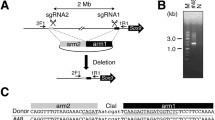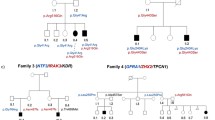Abstract
Mice homozygous for the lethal spotting (ls) mutation exhibit aganglionic megacolon and a white spotted coat owing to a lack of neural crest-derived enteric ganglia and melanocytes. The ls mutation disrupts the migration, differentiation, or survival of these neural crest lineages during mammalian development. A human congenital disorder, Hirschsprung disease (HSCR), is also characterized by aganglionic megacolon of the distal bowel and can be accompanied by hypopigmentation of the skin. HSCR has been attrrbuted to multiple loci acting independently or in combination. The ls mouse serves as one animal model for HSCR, and the ls gene may represent one of the loci responsible for some cases of HSCR in humans. This study uses 753 N2 progeny from a combination of three intersubspecific backcrosses to define the molecular genetic linkage map of the ls region and to provide resources necessary for positional cloning. Similar to some cases of HSCR, the ls mutation acts semidominantly, its phenotypic effects dependent upon the presence of modifier genes segregating in the crosses. We have now localized the ls mutation to a 0.8-cM region between the D2Mit113 and D2Mit73/D2Mit174 loci. Three genes, endothelin-3 (Edn3), guanine nucleotide-binding protein α-stimulating polypeptide 1 (Gnas), and phosphoenolpyruvate carboxykinase (Pck1) were assessed as candidates for the ls mutation. Only Edn3 and Gnas did not recombine with the ls mutation. Mutational analysis of the Edn3 and Gnas genes will determine whether either gene is responsible for the neural crest deficiencies observed in ls/ls mice.
Similar content being viewed by others
References
Abbott, C., Malas, S., Pilz, A., Pate, L., Ali, R., Peters, J. (1994). Linkage mapping around the ragged (Ra) and wasted (wst) loci on distal mouse chromosome 2. Genomics 20, 94–98.
Beechey, C.V. (1989). Linkage studies with T(2:14)48H. Mouse News Lett. 84, 85–86.
Beechey, C.V., Peters, J., Ball, S.T., (1992). Mapping studies of distal chromosome 2 including the imprinting region. Mouse Genome 90, 423–424.
Bronner-Fraser, M. (1993). Mechanisms of neural crest cell migration. Bioessays 15, 221–230.
Cole, G.W., Barr, R.J. (1987). Hypomelanosis associated with a colonic abnormality: a possible result of defective development of the neural crest. Am. J. Dermatopathol. 9, 45–50.
Dietrich, W., Katz, H., Lincoln, S.E., Shin, H., Friedman, J., Dracopoli, N.C. Lander, E.S. (1992). A genetic map of the mouse suitable for typing intraspecific crosses. Genetics 131, 423–447.
Dietrich, W., Miller, J., Katz, H., Joyce, D., Steen, R., Lincoln, S., Daly, M., Reeve, M., Weaver, A., Anagnostopoulos, P., Goodman, N., Dracopoli, N., Lander, E. (1993). Genetic Maps, S.J. O'Brien, ed. (Cold Spring Harbor, N.Y.: Cold Spring Harbor Laboratory Press), pp. 4.110–4.142.
Dunn, L.C., Charles, D.R. (1937). Studies on spotting patterns 1. Analysis of quantitative variations in the pied spotting of the mouse. Genetics 22, 14–42.
Edery, P., Lyonnet, S., Mulligan, L.M., Pelet, A., Dow, E., Abel, L., Holder, S., Nihoul-Fekete, C., Ponder, B.A.J., Munnich, A. (1994). Mutations of the RET proto-oncogene in Hirschsprung's disease. Nature 367, 378–380.
Green, M.C. (1981). Gene mapping. In The Mouse in Biomedical Research I, H.L. Foster, J.D. Small, J.G. Fox, eds. (New York: Academic Press), pp. 105–117.
Green, M.C. (1989). Catalog of mutant genes and polymorphic loci. In Genetic Variants and Strains of the Laboratory Mouse, M.F. Lyon, A.G. Searle, eds. (Oxford: Oxford University Press), pp. 12–403.
Hirschsprung, H. (1888). Stuhltragheit Neugeborener in Folge von Dilatation und Hypertrophie des Colons. Jahrb. Kinderheilk 27, 1–7.
Hussussian, C.J., Struewing, J.P., Goldstein A.M., Higgins, P.A., Ally, D.S., Sheahan, M.D., Clark, W.H., Tucker, M.A., Dracopoli, N.C. (1994). Germline p16 mutations in familial melanoma. Nature Genet. 8, 15–21.
Jacobs-Cohen, R.J., Payette, R.F., Gershon, M.D., Rothman, T.P. (1987). Inability of neural crest cells to colonize the presumptive aganglionic bowel of ls/ls mutant mice: requirement for a permissive microenvironment. J. Comp. Neurol. 255, 425–438.
Kapur, R.P., Yost, C., Palmiter, R.D. (1992). A transgenic model for studying development of the enteric nervous system in normal and aganglionic mice. Development 116, 167–176.
Kapur, R.P., Yost, C., Palmiter, R.D. (1993). Aggregation chimeras demonstrate that the primary defect responsible for aganglionic megacolon in lethal spotted mice is not neuroblast autonomous. Development 117, 993–999.
Kissel, P., Andre, J.M., Jacquier, A. (1981). The Neurocristopathies. (New York: Masson Publishing USA, Inc.).
Lander, E.S., Schork, N.J. (1994). Genetic dissection of complex traits. Science 265, 2037–2054.
Lane, P.W. (1966). Association of megacolon with two recessive spotting genes in the mouse. J. Hered. 57, 29–31.
Lane, P.W. (1982). Dominant megacolon (Dom). Mouse News Lett. 66, 66.
Lane, P.W., Liu, H.M. (1984). Association of megacolon with a new dominant spotting gene (Dom) in the mouse. J. Hered. 75, 435–439.
Levesque, H., Moore, N., Cailleux, N., Richard, V., Thuillez, C., Courtoius, H. (1994). Endothelins: a potential target for pharmacological intervention in diseases of elderly. Drugs Aging 4, 221–237.
Liddell, R.A., Thibaudeau, G., Maddison, P., Goldstein, C., McHugh, K.M., Siracusa, L.D., Pavan, W.J. (1994). Molecular genetic mapping of the lethal spotting (ls) mutation in the mouse. Mouse Genome 92, in press.
Liu, J., Hanson, R.W. (1991). Regulation of phosphoenolpyruvate carboxykinase (GTP) gene transcription. Mol. Cell. Biochem. 104, 89–100.
Ma, Q., Alder, H., Nelson, K.K., Chatterjee, D., Gu, Y., Nakamura, T., Canaani, E., Croce, C.M., Siracusa, L.D., Buchberg, A.M. (1993). Analysis of the murine All-1 gene reveals conserved domains with human ALL-1 and identifies a motif shared with DNA methyltransferases. Proc. Natl. Acad. Sci. USA 90, 6350–6354.
Malas, S., Peters, J., Abbott, C. (1994). The genes for endothelin 3, vitamin D 24-hydroxylase, and melanocortin 3 receptor map to distal mouse Chromosome 2, in the region of conserved synteny with human Chromosome 20. Mamm. Genome 5, 577–579.
Mayer, T.C. (1965). The development of piebald spotting in mice. Dev. Biol. 11, 319–334.
Mayer, T.C., Maltby, E.L. (1964). An experimental investigation of pattern development in lethal spotting and belted mouse embryos. Dev. Biol. 9, 269–286.
Meier-Ruge, W. (1974). Hirschsprung disease: its aetiology, pathogenesis, and differential diagnosis. Curr. Top. Pathol. 79, 131–179.
Passarge, E. (1980). Genetics of common gastrointestinal malformations and the heterogeneity of Hirschsprung's disease. In The Genetics and Heterogeneity of Common Gastrointestinal Disorders, J.I. Rotter, I.M. Samloff, D.L. Rimoin, eds. (New York: Academic Press), pp. 441–449.
Pavan, W.J., Tilghman, S.M. (1994). Piebald lethal (s 1) acts early to disrupt the development of neural crest-derived melanocytes. Proc. Natl. Acad. Sci. USA 91, 7159–7163.
Payette, R.F., Tennyson, V.M., Pomeranz, H.D., Pham, T.D., Rothman, T.P., Gershon, M.D. (1988). Accumlation of components of basal laminae: association with the failure of neural crest cells to colonize the presumptive aganglionic bowel of ls/ls mutant mice. Dev. Biol. 125, 341–360.
Phillips, R.J.S. (1966). New linkages: lethal-spotting. Mouse News Lett. 34, 27.
Puffenberger, E.G., Kauffman, E.R., Bolk, S., Matise, T.C., Washington, S.S.. Angrist, M., Weissenbach, J., Garver, K.L., Mascari, M., Ladda, R., Slaugenhaupt, S.A., Chakravarti, A. (1994). Identify-by-descent and association mapping of a recessive gene for Hirschsprung disease on human chromosome 13q22. Hum. Mol. Genet. 3, 1217–1225.
Romeo, G., McKusick, V.A., (1994). Phenotypic diversity, allelic series and modifier genes. Nature Genet 7, 451–453.
Romeo, G., Ronchetto, P., Luo, Y., Barone, V. Seri, M., Ceccherini, L., Pasini, B., Bocciardi, R., Lerone, M., Kaarianen, H., Martucciello, G. (1994). Point mutations affecting the tyrosine kinase domain if the RET proto-oncogene in Hirschsprung's disease. Nature 367, 377–378.
Schuchardt, A., D'Agati, V., Larsson-Blomberg, L., Costantini, F., Pachnis, V. (1994). Defects in the kidney and enteric nervous system of mice lacking the tyrosine kinase receptor Ret. Nature 367, 380–383.
Silvers, W. (1979). The Coat Colors of Mice. (New York: Springer-Verlag).
Simon, M.I., Strathman, M.P., Gautam, N. (1991). Diversity of G proteins in signal transduction. Science 252, 802–808.
Siracusa, L.D., Abbott, C.M. (1994). Mouse Chromosome 2. Mammalian Genome (Suppl.), in press.
Siracusa, L.D., Buchberg, A.M., Copeland, N.G., Jenkins, N.A. (1989). Recombinant inbred strain and interspecific backcross analysis of molecular markers flanking the murine agouti coat color locus. Genetics 122, 669–679.
Tennyson, V.M., Payette, R.F., Rothman, T.P., Gershon, M.D. (1990). Distribution of hyaluronic and chondroitin sulfate proteoglycans in the presumptive aganglionic terminal bowel of ls/ls fetal mice: an ultrastructural analysis. J. Comp. Neurol. 291, 345–362.
Warner, T.D. (1993). Characterization of endothelin synthetic pathways and receptor subtypes: physiological and pathophysiological implications. Eur. Heart J. 14, 42–47.
Weinstein, L.S., Shenker, A. (1993). G protein mutations in human disease. Clin. Biochem. 26, 333–338.
Wilkie, T.M., Gilbert, D.J., Olsen, A.S., Chen, X-N., Amatruda, T.T., Korenberg, J.R., Trask, B.J., de Jong, P., Reed, R.R., Simon, M.I., Jenkins, N.A., Copeland, N.G. (1992). Evolution of the mammalian G protein α subunit multigene family. Nature Genet. 1, 85–91.
Author information
Authors and Affiliations
Additional information
Both authors contributed equally to this research.
Rights and permissions
About this article
Cite this article
Pavan, W.J., Liddell, R.A., Wright, A. et al. A high-resolution linkage map of the lethal spotting locus: a mouse model for Hirschsprung disease. Mammalian Genome 6, 1–7 (1995). https://doi.org/10.1007/BF00350885
Received:
Accepted:
Issue Date:
DOI: https://doi.org/10.1007/BF00350885




